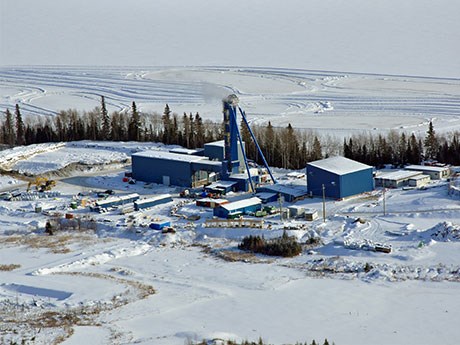The Phoenix Gold Mine is expected to produce 165,300 ounces of gold per year
Junior mining companies are down for the count as a result of the drying up of capital markets, but the fevered pace of exploration in the years of record spending between 2010 and 2012 is paying off as the best projects advance toward development.
One of those projects, Rubicon Minerals’ Phoenix Gold Project in Red Lake, Ontario, is scheduled to begin producing gold by mid-2015.
The Phoenix Gold Mine is expected to produce 165,300 ounces of gold per year at an all-in sustaining cost of US$870 per ounce over a projected mine life of 13 years. It boasts a mineral resource of 4.1 million tonnes grading 8.52 g/t Au for 1.3 million contained ounces and an inferred resource of 7.5 million tonnes grading 9.26 g/t gold for a total of 2.2 million ounces at a 4 g/t cutoff.
In a press release issued December 18, the company announced that it had already started stockpiling mineralized development material from underground stopes on the 244 and 305-metre levels.
As of the end of November, 3,586 metres of the planned 8,023 metres of total underground development had been completed.
The Phoenix mill was also on budget and on schedule for commissioning by mid-year.
As of November 30th, capital expenditures for the Phoenix project totaled $299 million, with a further $85 million left to spend.
The operation is fully permitted for initial production of 1,250 tonnes per day and the recent signing of a settlement agreement with the Wabauskang First Nation terminated court action challenging the legality of its closure plan.
Wabauskang dropped its suit against the company and agreed to support its exploration work in return for “certain benefits to (the First Nation) based on exploration expenditures” on its traditional lands. The company also has agreements with the Lac Seul First Nation and the Métis Nation of Ontario. The Phoenix project is partially funded through a gold streaming agreement with Royal Gold Inc. In return for US$75 million paid over five installments, Royal Gold will buy 6.3 per cent of the mine’s projected annual gold production up to 135,000 ounces for 25 per cent of the spot price. Thereafter, Royal Gold will buy 3.15 per cent of the mine’s annual production on the same basis.
In January, Rubicon had a workforce of 212 with plans to increase its workforce to 304 by June. Heading up Rubicon’s management team is president and CEO Michael Lalonde. Born and raised in Timmins, Lalonde joined Rubicon in 2012. Prior to joining Rubicon, he served in several senior management roles with Goldcorp, including a stint as mine general manager at Goldcorp’s flagship Red Lake Mine.
Also on the team are vice-president of operations Daniel Labine, who served as senior project manager overseeing Goldcorp’s Cochenour project, vice-president and CFO Nicholas Nikolakakis, formerly of Rainy River Resources, and vice-president of exploration Howard Bird, formerly of Brigus Gold.


